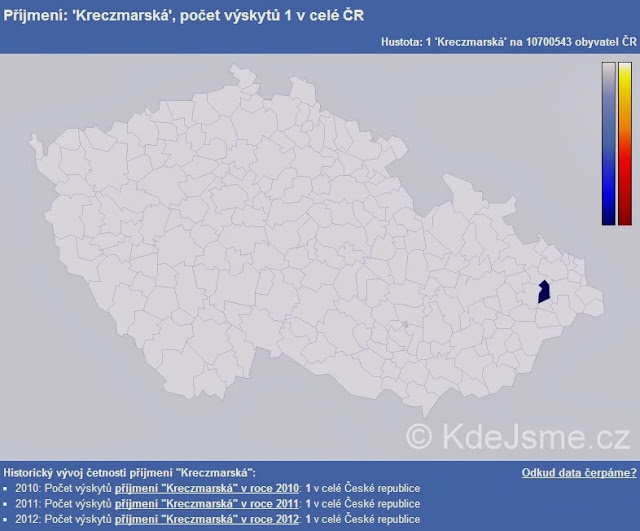In my previous post about my fourth great grandmother, Anna Kreczmarska, I linked to the surname density map kdejsme.cz for the surname Krečmar. This variant spelling is not found anywhere close to Ostrava. However, a friend pointed me in the direction of a different surname spelling variation: Kreczmarská and Kreczmarski.
In an email correspondence with Carolyn Sumbera Heinsohn, author and researcher of the book, “A History of the Sumbera, Mozisek, and Kruppa Families” I learned that the surname could have been spelled with a Polish twist since they were part of Silesia (Kretzmar), or also a German spelling like Kretzschmar, Kretschmar, Kretzschmar.
When I tried to search for Kretzschmar, I also got results that were close to Ostrava!
Does this indicate that the ethnic origins of Anna Kreczmarská are German? If the family immigrated to the Czech border regions ~16th Century (this guess is based on a statement by Carolyn that the Fischer/Fišer family, who is distantly related to the Kreczmars, is documented as being in northeast Bohemia since the mid-16th century – so it really has almost no basis on reality or fact) are they still German, or are they as Czech as anybody else in that region?
How long does it take to gain an ethnic identity? Do the current Kreczmars/Kretzchmars living in the Ostrava region consider themselves Czech, German, Moravian, Silesian, or a combination of all of the above?
I tease my husband about me being “more American” than him because when we played with rootsmapper.com (a site that uses the familysearch API to plot your direct line ancestors on a map up to 7 generations) I had way, way, way more ancestors in the United States than he did. His were almost 100% from the British Isles and Ireland. He has almost no colonial American ancestors. I do.
I have often had the conversation with other Americans about, “What are you?” and then people listing off a bunch of European countries where their ancestors are from. I wonder if this conversation happened much in the Czech lands in the 18th-19th centuries. I’m guessing…not so much…



